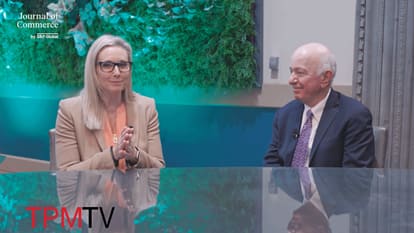- Program
- What's New
- Speakers
- Who's Attending
- TPM Community
- Partners
- Media

TPM TV
Episodes of exclusive TPM content featuring interviews of key stakeholders and attendees.
WATCH NOW - About

About TPM
The must-attend conference for the trans-Pacific and global container shipping and logistics community
LEARN ABOUT TPM - Get Updates
- FAQ's
Sessions With Peter Tirschwell
Monday, 4 March
-
08:30am - 08:50am (PST) / 04/mar/2024 04:30 pm - 04/mar/2024 04:50 pm
-
11:30am - 12:15pm (PST) / 04/mar/2024 07:30 pm - 04/mar/2024 08:15 pm
TPM24 CEO Series: A Conversation with Hapag-Lloyd's Rolf Habben Jansen
At TPM24 we are delighted to present a one-on-one conversation with Hapag-Lloyd CEO Rolf Habben Jansen. As head of the 5th largest container line and co-chair of the World Shipping Council, Rolf will comment on a wide range of topics relevant to the 2024 market including supply, demand, capacity management, service quality, Panama Canal restrictions, geopolitics including attacks on shipping in the Red Sea, decarbonization and technology. In recent public appearances he has been outspoken about the negative impact of Panama Canal navigational restrictions and what he perceives to be a disconnect between depressed freight rates and ships sailing mostly full. “Market utilization is high as reported by most carriers, which means the ships are full,” he told a webinar in early December. “There are also reports out there of boxes being rolled. Most of the talk was about a big gap between supply and demand, but I don’t see that,” he added. Present at COP28 in December, he was part of a group of carrier CEOs calling for a global carbon tax to neutralize the cost differential between zero carbon fuels and traditional bunkers, as well as other policy recommendations, a topic we will cover given the critical two-year rulemaking now commencing at the International Maritime Organization.- Speakers:
- Rolf Habben Jansen
- Peter Tirschwell
-
02:00pm - 02:45pm (PST) / 04/mar/2024 10:00 pm - 04/mar/2024 10:45 pm
What Should BCOs Do If East Coast Labor Peace Is No Longer Guaranteed?
Is labor peace on the East Coast a sure thing? Aside from a few minor and short-lived incidents, labor peace has reigned over the US East Coast since the late 1970s. The sharp contrast to the West Coast, which has experienced disruption, occasionally severe, during every contract negotiation going back to the 1990s, has given BCOs a high degree of confidence when considering alternative routings into the US market. In addition to demographic shifts, labor stability has contributed to the long-term shift in Asia import market share from the West to the East and Gulf coasts. But a long-simmering dispute has given shippers pause. Under longstanding practice going back to early days of containerization, the International Longshoremen’s Association does not represent the operators of cranes and yard equipment at three state-operated ports in the Southeast: Savannah, Charleston, and Wilmington, North Carolina. It wants to change that. Its opening was a clause in its contract negotiated years ago giving it jurisdiction over those jobs at any newly opened terminal. Disagreement over what that means in practice has kept Phase 1 of the Hugh Leatherman Terminal at Charleston largely empty since it opened in early 2021. Litigation has only further emboldened the union to seek changes, not just at Charleston but at the other ports as well. This session will update where this stands as the ILA and US Maritime Association prepare to begin negotiations on a new contract to replace the six-year pact that expires on September 30.Related Content:
- Speakers:
- Patrick Burgoyne
- Peter Tirschwell
- Michael Angell
Tuesday, 5 March
-
08:45am - 09:20am (PST) / 05/mar/2024 04:45 pm - 05/mar/2024 05:20 pm
A Conversation with the One and Only Otto Schacht
There are many Steves, Alans, Pauls, and Steens, but there is only one Otto. Ask those who have worked or interacted with Otto Schacht, the longtime head of seafreight at Küehne + Nagel, and they will describe a friend, mentor, confidant, and unparalleled authority on the container shipping industry. During more than 25 years leading the world’s largest ocean freight forwarder — where he helped build a globally respected brand — following 20 years at Hapag-Lloyd, Otto has been a power broker in the industry’s inner sanctum during periods of calm and tumult. He has had a uniquely insider’s view of the industry and all its inner workings that he rarely shares publicly. Now, as he transitions into semiretirement, he has kindly agreed to a one-on-one sit-down at TPM24, where he will look back and forward, take stock and offer guidance, and take your questions as the industry heads into a new post-COVID era.
- Speakers:
- Otto Schacht
- Peter Tirschwell
-
10:30am - 11:00am (PST) / 05/mar/2024 06:30 pm - 05/mar/2024 07:00 pm
A Conversation With “Our Man in DC” Peter Friedmann
The past few years, since the early days of COVID, have been the most active period in memory for container shipping in Washington regarding legislation, regulation, and politics. This year — an election year — will be no different. When COVID hit early in 2020, longer-term shifts in the landscape were already well under way. Ocean carriers’ power was waning as Sea-Land, APL, and others had been sold, and the center of political gravity had shifted to US-based shippers. COVID catalyzed those changes; as ships and cargo backed up, rates spiked, and service levels collapsed, shippers took to the halls of Congress and successfully pressed for passage of the 2022 Ocean Shipping Reform Act over ocean carriers’ objections. The Federal Maritime Commission, meanwhile, long a bastion of carrier influence, shifted course under Chairman Daniel Maffei, a former New York congressman, becoming a de facto “consumer protection agency” for shippers seeking relief. Peter Friedmann, executive director of the Agriculture Transportation Coalition and known as “Our Man in DC,” has been one of the most influential players in this arena for many years and was a driving force behind enactment of OSRA 2022. In this session, we will ask him where US trade and transportation policy, FMC regulation and legislation is headed in this volatile election year and what it means for shippers/BCOs. We will specifically ask about the FMC’s aggressive enforcement; implementing the detention/demurrage rule; and the FMC’s recent multibillion-dollar “Box Rules” Order.
- Speakers:
- Peter Friedmann
- Peter Tirschwell
-
03:05pm - 03:50pm (PST) / 05/mar/2024 11:05 pm - 05/mar/2024 11:50 pm
Understanding the Asia Container Shipping Environment
Understanding current, complex container shipping dynamics within APAC is crucial to any supply chain connecting Asia to North America, Europe, or other consumer market. An evolving and overlapping set of forces is shaping growth in the region and connecting it to consumer markets globally. These include the impact of geopolitics, “China+1” resourcing trends, (which some still see as early days), China’s reorientation of its own export machine toward renewables, as well as growing investment by multinationals to cater to the region’s own consumer growth. Reflecting growth in components and consumer goods trade, intra-ASEAN share of total global trade by value has grown by half a percentage point from 4.5% to 5% since the beginning of 2020. Supporting the growth is an expansive network estimated at 87 regional and global ocean carriers plying more than 10,000 unique trade lanes, with multiple departures per hour and customers frequently demanding precise departures and arrivals. Despite the fragmented market, intra-Asia rates have held up given the strength of demand and carriers’ ability in the aggregate to flex capacity in response to short-term changes in demand. This session, featuring APAC-based shipping and logistics leaders and led by Journal of Commerce vice president Peter Tirschwell, now based in Singapore, will cover a broad perspective for BCOs managing Asia supply chains.
Wednesday, 6 March
-
08:30am - 09:00am (PST) / 06/mar/2024 04:30 pm - 06/mar/2024 05:00 pm
Guidance to BCOs in the Post-COVID Environment
In his late-November newsletter, consultant Jon Monroe says “BCOs have a lot to think about and plan for, to get ready for 2024. There are so many underlying obstacles or potential headwinds that will need to be addressed.” Among those are the possibility of the market unexpectedly tightening — despite the prevailing narrative of overcapacity and the failure of multiple carrier GRI attempts in 2023 — and how BCOs should plan for what might seem like a remote possibility. “Looking ahead to 2024, there is a concern: if carriers choose to tighten capacity with the same intensity as witnessed in 2020, the market may once again grapple with soaring rates and constrained vessel space,” he wrote to subscribers. Industry stakeholders listen to Jon because he is the rare individual in shipping today who brings to the table the full gamut of experience and the willingness and ability to expound publicly and articulately in ways that are highly relevant to BCOs and other market participants. In a career stretching back to United States Lines, he logged time with a variety of organizations, including Circle International, Emery Worldwide, Hyundai Merchant Marine, Top Ocean, DeWell, and Transfar Shipping. In addition, he has built significant BCO technology platforms that are in use today. In a late-2023 market that looks deceptively similar coming out of COVID versus how it entered it, the reality is it’s a new world that requires players across the spectrum to reorient themselves anew. To do that. it’s worth spending time with Jon, who will bring his perspective to the TPM24 audience as one of the rare individuals who can provide the informed straight talk that market participants will find certain value in.
- Speakers:
- Peter Tirschwell
- Jon Monroe
-
09:55am - 10:40am (PST) / 06/mar/2024 05:55 pm - 06/mar/2024 06:40 pm
Case Study: Castlery — A Strategic Partnership That Emerges from Maersk's Integrator Strategy
When Maersk in 2016 set off down the road of integrating traditional shipping and logistics services into an end-to-end offering — something that had never been tried let alone accomplished before — many wondered how it could successfully weave together multiple services to create genuine value for customers’ supply chains. An answer to that question comes from its relationship with Castlery, a fast-growing Singapore-based direct-to-consumer furniture retailer that designs and produces stylish, modern furniture. Castlery launched retail operations in the US in 2019 and became a Top 30 Home Furnishing website in the US in 2023. It is using almost all types of logistics services provided by Maersk, and is currently exploring a flexible warehousing model to support further geographic expansion in the US market. With Maersk, Castlery has developed an increasingly deeper strategic partnership over the past six years. “As our business becomes more global, we are able to tap on Maersk's global scale and high-quality integrated logistics services, and have benefited tremendously in our growth,” the company said. This case study will illustrate the benefits from a retailer’s perspective of leveraging an integrated service that incorporates ocean together with multiple other services.
- Speakers:
- Elizabeth Hemann
- Yao Zhang
- Peter Tirschwell

